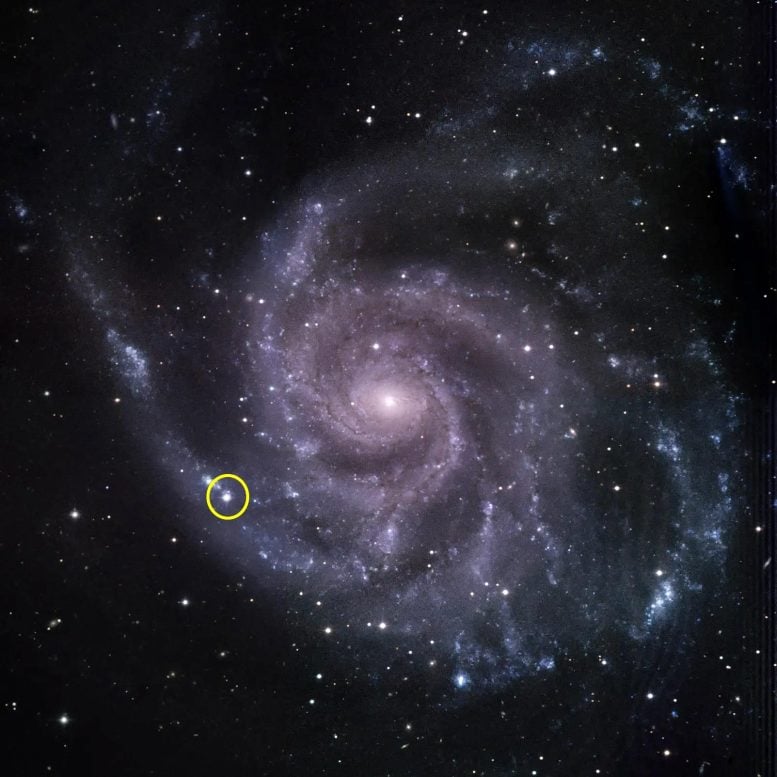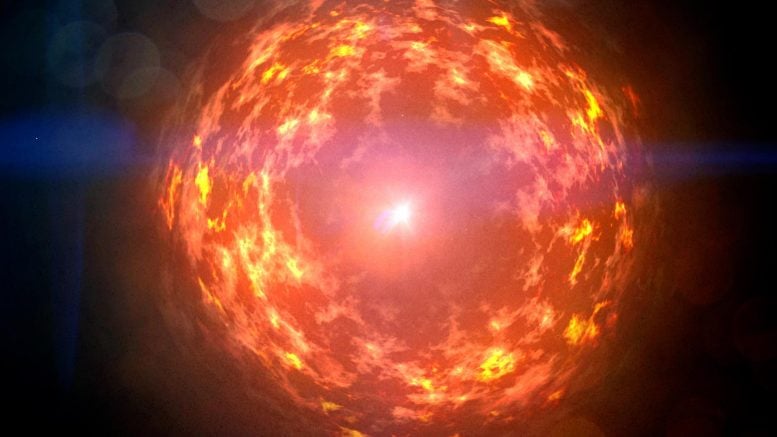Observations of the Pinwheel Galaxy supernova SN 2023ixf in 2023 provided a unique opportunity to study cosmic ray production, but NASA’s Fermi telescope did not detect the expected gamma rays, indicating a much lower energy conversion rate than expected.Image source: NASA
Observations of SN 2023ixf in 2023 led to surprising discoveries about the production of cosmic rays from supernovae, which has potential implications for understanding the origin and acceleration mechanisms of cosmic rays.
In 2023, a nearby supernova gave astrophysicists the perfect opportunity to test the idea of how these types of explosions can boost particles called cosmic rays to nearly the speed of light. But surprisingly, NASA’s Fermi Gamma-ray Space Telescope did not detect the high-energy gamma-ray light these particles should produce.
On May 18, 2023, a supernova exploded in the nearby Pinwheel Galaxy (Messier 101), which is about 22 million light-years away in the constellation Ursa Major. The event, named SN 2023ixf, is the brightest nearby supernova discovered since Fermi’s launch in 2008.
Unexpected results from the Fermi telescope
“Astrophysicists have previously estimated that supernovae convert about 10% of their total energy into cosmic ray acceleration,” said Guillem Marti-Devesa, a researcher at the University of Trieste in Italy. “But we have never Directly observing this process. Based on the new observations of SN 2023ixf, we calculate that the energy conversion is as low as 1% in the days after the explosion. This does not rule out supernovae as cosmic ray factories, but it does mean that we have no idea about their production. Learn more.
The paper, led by Martí-Devesa at the University of Innsbruck in Austria, will appear in a future edition of Astronomy and Astrophysics.
Even if it doesn’t detect gamma rays, NASAThe Fermi Gamma-ray Space Telescope helps astronomers learn more about the universe.Image source: NASA Goddard Space Flight Center
Cosmic rays and their origins
Trillions of cosmic rays collide with the Earth’s atmosphere every day. About 90% of these are hydrogen nuclei (or protons), and the remainder are electrons or nuclei of heavier elements.
Scientists have been studying the origins of cosmic rays since the early 1900s, but have been unable to trace these particles back to their source. Because cosmic rays are electrically charged, they change course when they encounter a magnetic field when they reach Earth.
“However, gamma rays are coming directly at us,” said Elizabeth Hayes, a Fermi project scientist at NASA’s Goddard Space Flight Center in Greenbelt, Maryland. “Gamma rays are produced when cosmic rays interact with matter in the environment. Fermi is the most sensitive gamma-ray telescope in orbit, so when it doesn’t detect the expected signal, scientists have to explain the phenomenon.” Solving this mystery will build a more accurate picture of the origins of cosmic rays.

The Fred Lawrence Whipple Observatory’s 48-inch telescope captured this visible-light image of the Pinwheel Galaxy (Messier 101) in June 2023. The observatory is located at Mount Hopkins, Arizona, and is operated by the Center for Astrophysics at Harvard and the Smithsonian. Image source: Hiramatsu et al. 2023/Sebastian Gomez(STScI)
Supernovae as cosmic ray accelerators
Astrophysicists have long suspected that supernovae are major contributors to cosmic rays.
These explosions occur when stars at least eight times more massive than the Sun run out of fuel. The core collapses and then rebounds, pushing a shock wave outward through the star. The shock wave accelerates particles, producing cosmic rays. When cosmic rays collide with other matter and light around the star, they produce gamma rays.
Supernovae greatly affect the interstellar environment of galaxies. Their shock waves and expanding clouds of debris may last for more than fifty thousand years. In 2013, Fermi measurements showed that supernova remnants exist in our own galaxy Milky Way Galaxies are accelerating cosmic rays, which produce gamma rays when they hit interstellar material. But astronomers say the remnants didn’t produce enough high-energy particles to match scientists’ measurements on Earth.
One theory is that supernovae may accelerate the most energetic cosmic rays in the Milky Way in the first days and weeks after the initial explosion.
But supernovae are very rare, occurring only a few times a century in galaxies like the Milky Way. At a distance of about 32 million light-years, supernovae occur only once a year on average.
After a month of observations, since the visible light telescope first saw SN 2023ixf, Fermi has not detected a gamma ray.
Challenges and future research
“Unfortunately, just because you don’t see gamma rays doesn’t mean you don’t have cosmic rays,” said co-author Matthieu Renaud, an astrophysicist at the French National Center for Scientific Research’s Laboratory of Cosmology and Particles in Montpellier. )explain. “We have to carefully study all the basic assumptions about the acceleration mechanism and environmental conditions in order to translate the absence of gamma rays into an upper limit for cosmic ray production.”
The researchers proposed a number of scenarios that could affect Fermi’s ability to see gamma rays from the event, such as the way the explosion distributed debris and the density of material surrounding the star.
Fermi’s observations provided the first opportunity to study what happens after a supernova explosion. Additional observations of SN 2023ixf at other wavelengths, new simulations and models based on the event, and future studies of other young supernovae will help astronomers gain insight into the mysterious source of cosmic rays.
Fermi is an astrophysics and particle physics partnership managed by Goddard. Fermi was developed in collaboration with the U.S. Department of Energy, with important contributions from academic institutions and partners in France, Germany, Italy, Japan, Sweden and the United States.
#Unexpected #NASA #Fermi #sees #gamma #rays #nearby #supernova
Image Source : scitechdaily.com
